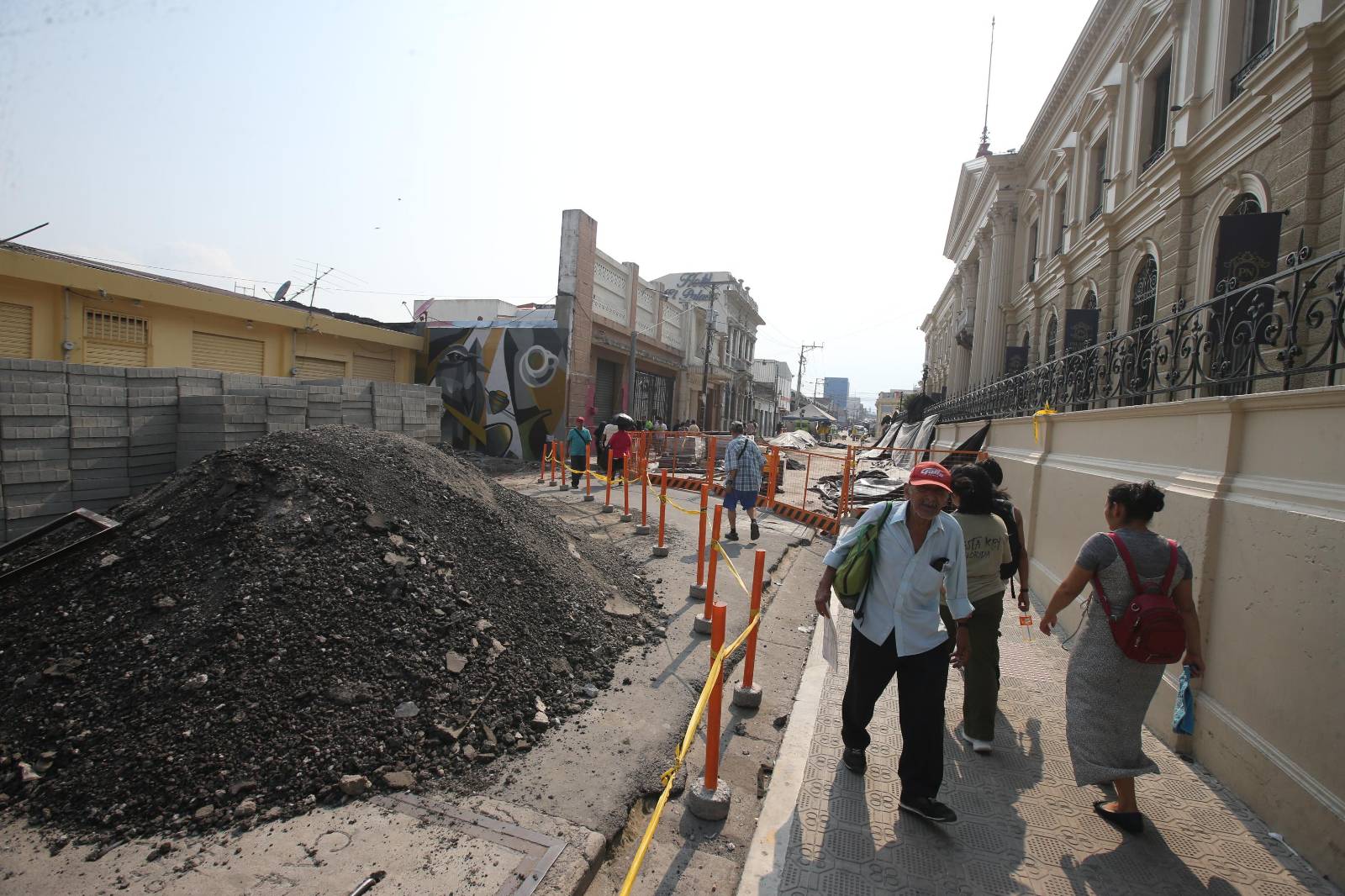The National Palace is being intervened by authorities from the Ministry of Public Works (MOP), and social media users have criticized the work on the infrastructure, considering that the cultural heritage of the Historic Center of San Salvador has been affected.
The Ministry of Culture announced since April 10th that the National Palace would remain closed to the public “due to improvement, maintenance, and restoration work.”
Through social network X (formerly Twitter), users reacted to the MOP and Culture’s work, pointing out that it is not being directed by restoration specialists, due to the removal of historical tiles installed since the early last century, as well as the paths of the internal garden.
Through different publications, users regretted that the National Palace building, declared a “National Monument” since July 10th, 1980, is being intervened.
One of the complaints was made by Salvadoran historian and researcher Carlos Cañas Dinarte, who said, “the destruction they are carrying out on the infrastructure of the Palace is irreversible.”
“Today, the National Palace has lost part of its cultural values: antiquity, aesthetic-architectural, and authenticity, which had been preserved intact over time, making it one of our best and most representative examples of our early 20th-century architecture,” he wrote.
“The partial destruction of the access and first level of that cultural heritage building that is the National Palace of San Salvador is irreversible,” Dinarte said.
Human rights defender David Morales said that the interventions in the place are “from deep ignorance and arrogance, like the National Library and the El Mozote village.”
“They destroy the common heritage to raise vain symbols, empty and trivial buildings that flatter the image of a dictator,” Morales stated.
The National Palace is located in the Historic Center of San Salvador. According to the Ministry of Culture, the historical building has main halls: Red, Blue, Pink, and Yellow, sixty-four large rooms, forty small rooms, eight service rooms, and two large basements, one to the east and the other to the west.
According to the Ministry of Culture, the National Palace housed the three branches of the State: the deputies of the Legislative Assembly in the Blue Hall until 1974; the Supreme Court of Justice (CSJ) also until 1974 in the Pink Hall, and the Yellow Hall was the office of the President of the Republic until 1930.
The National Palace was inaugurated on March 1st, 1911, and in its early days, it was called “The Coffee Palace,” as a legislative decree stipulated that one colon would be invested for every quintal of coffee exported to build the project. In total, 50,000 colones were used for its construction.
The National Palace currently has the blue shield, an emblem used for heritage protection.
Cuestionan intervenciones “irreversibles” en el Palacio Nacional: “Ha perdido hoy parte de sus valores culturales”
El Palacio Nacional está siendo intervenido por autoridades del Ministerio de Obras Públicas (MOP), y usuarios de redes sociales han criticado los trabajos en la infraestructura por considerar que se ha afectado el patrimonio cultural del Centro Histórico de San Salvador.
El Ministerio de Cultura anunció desde el pasado 10 de abril que el Palacio Nacional se mantendría cerrado al público “por trabajos de mejora, mantenimiento y restauración”.
A través de la red social X (antes Twitter), usuarios reaccionaron ante los trabajos del MOP y Cultura, y señalaron que estos no están siendo dirigidos por especialistas en restauración, debido al levantamiento de azulejo histórico instalado desde inicios del siglo pasado, así como los senderos del jardín interno.
A través de diferentes publicaciones, los usuarios lamentaron que el edificio del Palacio Nacional, declarado como “Monumento Nacional” desde el 10 de julio de 1980, esté siendo intervenido.
Una de las denuncias fue realizada por el historiador e investigador salvadoreño Carlos Cañas Dinarte, quién dijo “es irreversible la destrucción que están realizando en la infraestructura del Palacio”.
“El Palacio Nacional ha perdido hoy parte de sus valores culturales: de antigüedad, estético-arquitectónico y de autenticidad, los cuales se habían conservado intactos en el tiempo, haciéndolo uno de nuestros más y mejores exponentes de nuestra arquitectura de inicio del siglo XX”, escribió.
“Es irreversible la destrucción parcial del acceso y primer nivel de ese patrimonio cultural edificado que es el Palacio Nacional de San Salvador”, dijo Dinarte.
El defensor de derechos humanos, David Morales, dijo que las intervenciones al lugar son “desde la profunda ignorancia y la prepotencia, como la Biblioteca Nacional y como el caserío El Mozote”.
“Destruyen el patrimonio común para levantar símbolos fatuos, vacías y triviales edificaciones que envanezcan la imagen de un dictador”, afirmó Morales.
El Palacio Nacional está ubicado en el Centro Histórico de San Salvador. Según el Ministerio de Cultura. la edificación histórica cuenta con salones principales: El Rojo, Azul, Rosado y Amarillo, sesenta y cuatro salas grandes, cuarenta salas pequeñas, ocho salas para servicio y dos grandes sótanos ubicados uno al oriente y otro al poniente.
De acuerdo con la cartera de Cultura, el Palacio Nacional albergó los tres poderes del Estado: a los diputados de la Asamblea Legislativa en el Salón Azul hasta 1974; a la Corte Suprema de Justicia (CSJ) también hasta 1974 en el Salón Rosado, y el Salón Amarillo fue el despacho del presidente de la República hasta 1930.
El Palacio Nacional fue inaugurado el 1 de marzo de 1911 y en sus inicios fue llamado como “El Palacio del Café”, ya que a través de un decreto legislativo se estipuló que por cada quintal de café exportado se invertiría un colón para levantar la obra. En total se utilizaron 50 mil colones para edificarlo.
El Palacio Nacional cuenta actualmente con el escudo azul, un emblema utilizado para la protección del patrimonio.

